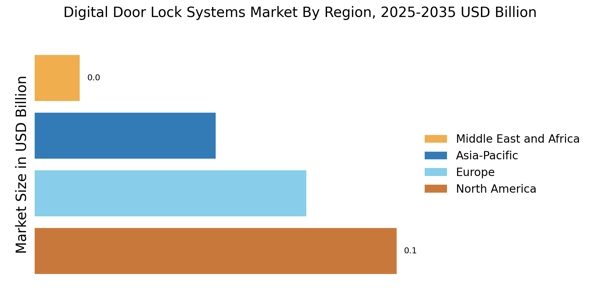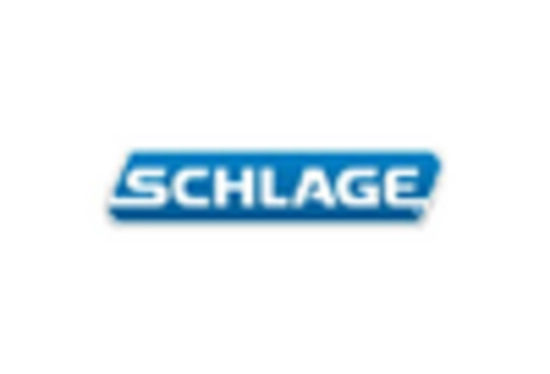Growing Adoption of Smart Home Technologies
The proliferation of smart home technologies significantly influences the Digital Door Lock Systems Market. As more households adopt smart devices, the demand for compatible digital door locks increases. These locks can seamlessly integrate with existing smart home ecosystems, allowing users to control access remotely and monitor their homes in real-time. Market data suggests that the smart home market is expected to reach substantial figures, with digital door locks being a crucial component of this ecosystem. This trend not only enhances convenience for users but also promotes energy efficiency and security. Consequently, the Digital Door Lock Systems Market is likely to experience robust growth as consumers increasingly prioritize smart home integration.
Rising Demand for Enhanced Security Solutions
The increasing concern for security in residential and commercial properties drives the Digital Door Lock Systems Market. As crime rates fluctuate, consumers seek advanced security measures to protect their assets. The market for digital door locks is projected to grow significantly, with estimates suggesting a compound annual growth rate of over 20% in the coming years. This surge is attributed to the growing awareness of security technologies and the need for reliable access control systems. Furthermore, the integration of digital locks with surveillance systems enhances overall security, making them a preferred choice for many. As a result, manufacturers are innovating to meet this rising demand, leading to a more competitive landscape in the Digital Door Lock Systems Market.
Technological Advancements in Locking Mechanisms
Technological innovations play a pivotal role in shaping the Digital Door Lock Systems Market. The advent of smart locks, which utilize Bluetooth, Wi-Fi, and mobile applications, has revolutionized traditional locking mechanisms. These advancements not only provide convenience but also enhance security features, such as remote access and real-time monitoring. The market is witnessing a shift towards locks that incorporate artificial intelligence and machine learning, allowing for adaptive security measures. As these technologies evolve, they are likely to attract a broader consumer base, including tech-savvy individuals and businesses looking for cutting-edge security solutions. The continuous development of these technologies indicates a promising future for the Digital Door Lock Systems Market.
Increased Focus on Aesthetic Appeal and Customization
The Digital Door Lock Systems Market is witnessing a shift towards aesthetic appeal and customization options. Consumers are increasingly looking for locks that not only provide security but also complement their home decor. Manufacturers are responding by offering a variety of designs, finishes, and functionalities that cater to diverse consumer preferences. This trend is particularly evident in the residential sector, where homeowners seek locks that enhance the overall look of their properties. Additionally, customization options, such as personalized access codes and unique designs, are becoming more popular. This focus on aesthetics and personalization is likely to drive growth in the Digital Door Lock Systems Market, as consumers are willing to invest in products that reflect their style.
Regulatory Compliance and Standards for Security Devices
Regulatory compliance and the establishment of standards for security devices significantly impact the Digital Door Lock Systems Market. Governments and regulatory bodies are increasingly implementing stringent security standards to ensure consumer safety. These regulations often mandate the use of advanced locking mechanisms in commercial and residential properties, thereby driving demand for digital door locks. Compliance with these standards not only enhances consumer trust but also encourages manufacturers to innovate and improve their products. As a result, the Digital Door Lock Systems Market is likely to benefit from these regulatory frameworks, which promote the adoption of secure and reliable locking solutions.

















Leave a Comment